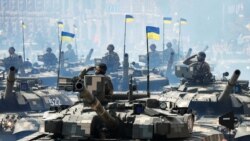On August 19, the Russian state news agency TASS reported on comments made by the Secretary of Russia’s Security Council, Nikolai Patrushev, who claimed Ukraine would be the next Afghanistan if the U.S. and NATO were to abandon its defense.
"Did the fact that Afghanistan having the status of a main U.S. ally outside of NATO save the ousted pro-American regime in Kabul?” Patrushev asked.
“A similar situation awaits those who are banking on America in Ukraine, where neo-Nazis are capable of taking power. The country is going to disintegrate, and the White House at a certain moment won’t even remember its supporters in Kyiv."
Patrushev’s comparison is both speculative and false. In fact, the two countries and their relationship to the United States could hardly be more different.
Unlike the post-2001 Afghan government, Ukraine’s government established and achieved independence itself in 1991 as a flawed but functioning democracy. Since then, Ukraine has had multiple contested elections and six different presidents.
Ukraine had been peaceful up until 2014, when Russia invaded and annexed part of the country, the Crimean peninsula. Afghanistan has been in a near-continuous state of war involving parties inside and out (Russia among them), dating to the late 1970s.
Also, unlike Afghanistan, Ukraine possesses a large, modern domestic defense industry, manufacturing everything from small arms and anti-tank guided missiles (ATGMs) to helicopters, fixed-wing aircraft, and long-range cruise missiles.
Not only does Ukraine manufacture its own arms and military equipment, but it also is an arms exporter. Although the U.S. has provided some military aid to Ukraine since 2014, and the country also has purchased U.S. weapons, most of its arms and equipment are made at home.
Another glaring difference is the Afghan government’s reliance on U.S. and NATO troops for security over the past two decades, up until the ongoing U.S. pullout.
In 2010, the U.S. military contingent reached its peak of approximately 100,000 troops in the country, not including military personnel from other countries. Even after most U.S. and allied troops left, the Afghan military depended on thousands of private contractors to handle various logistical and technical tasks. The Afghan Air Force depended heavily on foreign contractors to stay operational.
Ukraine does not have such dependencies.
The country carried out military exercises with NATO member states before the Crimean annexation in 2014. Since then, the only foreign military presence in Ukraine consists of observers and smaller military units conducting joint training exercises.
No U.S. or other NATO military personnel have ever taken part in the Donbas region, where Russian-backed separatists are fighting Ukraine. Nor have any NATO military units been permanently based or deployed in Ukraine for the purpose of participating in the war or defending against further Russian aggression.
In recent weeks, the world watched Afghan’s government military practically melt away in the face of the Taliban’s offensive in anticipation of permanent U.S. troop withdrawals this month. Mass surrenders and desertions took place.
One of the major reasons was soldiers and other security personnel not being paid. By comparison, Ukraine’s military personnel have seen a series of pay raises since 2014.
Ukraine has shown no signs of “dissolution,” as Patrushev claimed. Territories in Donbas retaken by Kyiv-loyal forces in the summer of 2014 have not experienced any kind of organized insurgent activity.
As for Patrushev’s claims of “neo-Nazis” coming to power, this has been a common theme of Russian disinformation since 2014. Polls and elections have shown that Ukraine’s far-right has had dismal support since the 2014 Euromaidan revolution that ousted former Ukrainian President Viktor Yanukovych.
Despite the street presence of certain far-right groups, there is no evidence they have broadening support or building any ability to come to power. Furthermore, some prominent figures in the Ukrainian far-right are suspected of ties to Russian intelligence.
This is again in stark contrast to the Taliban, an insurgent movement that had the backing of Pakistan and had all but won control of Afghanistan by the end of the 1990s.
On August 24, Ukraine celebrated 30 years of independence with a military parade in Kyiv.






